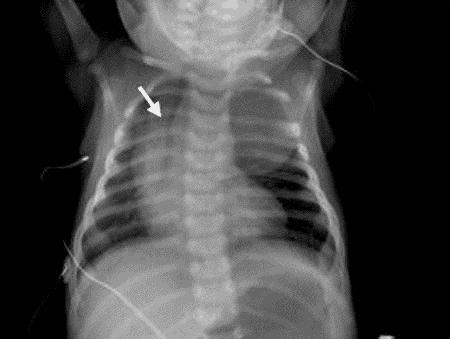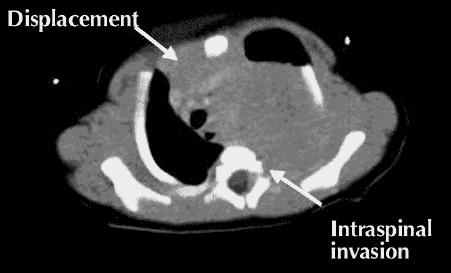A baby girl was noted to have stridor on day 1 of life. Her examination was otherwise normal, and a provisional diagnosis of laryngomalacia was made. However, she continued to have intermittent tachypnea, vomiting and diaphoresis with feeds. An echocardiogram revealed a patent ductus arteriosus, an atrial septal defect and mild pulmonary stenosis. Over the next 2 weeks her symptoms worsened and weight gain was poor.
On examination, her respiratory rate was 66 breaths/min, heart rate 130–140 beats/min, blood pressure 86/54 mm Hg and oxygen saturation 95%– 98% on room air. Auscultation of the chest revealed a systolic ejection murmur, heard best at the left upper sternal border, and decreased air entry over the left lung base. A chest radiograph revealed a posterior mediastinal mass on the left side with tracheal shift to the right (Fig. 1, arrow). A CT scan showed a localized mass in the upper posterior mediastinum with extension into adjacent intervertebral foramina (Fig. 2, right arrow); the heart, great vessels and trachea were deviated to the right (left arrow). MRI and ultrasonography revealed no compression of the spinal cord.
Figure 1.

Figure 2.

Neuroblastoma was diagnosed on the basis of the patient's age, the mediastinal location and the appearance of the mass (calcifications and intraspinal invasion seen on ultrasound); elevated urine catecholamine levels for homovanillic acid (HVA) and vanillylmandelic acid (VMA) also supported the diagnosis (HVA and VMA levels are elevated in more than 90% of patients with neuroblastoma, and their measurement is thus useful to help distinguish different tumours in young children).
The bulk of the tumour except the intraspinal portion was surgically resected. Histologic test results confirmed neuroblastoma, with favourable findings (a low mitotic rate and stroma content and low levels of the oncogene N-myc). The girl's respiratory symptoms improved postoperatively and she was given 4 cycles of chemotherapy. She had normal motor and cognitive development at 9 months of age.
Neuroblastoma is the most common malignant disease in the first year of life and usually arises from the adrenal medulla or parasympathetic ganglia. The thoracic and lumbar paraspinal regions are most often involved, but mediastinal masses may be associated with thoracic intraspinal disease, as was seen in our patient.
Children over 1 year old usually present with an abdominal mass, fever and weight loss and may also have bone pain or other evidence of metastatic disease. These children with advanced disease have a poor outcome despite intensive therapy. In contrast, children less than 1 year old usually have localized disease, with presenting symptoms reflecting the anatomic location of the mass. In infants, tumours occur most often in the thorax, the next most common sites being the adrenal glands, liver and spine. Symptoms may include respiratory distress, hepatomegaly and decreased limb movements.
A small proportion of neuroblastomas originate in utero and may be detected by means of fetal ultrasonography in the third trimester.1 These tumours may undergo spontaneous regression before birth or persist to become symptomatic in the neonate.
The majority of congenital neuroblastomas are localized, and those with favourable histologic and genetic features are treated by surgical resection alone, with an overall survival rate of 90%– 95%. More advanced tumours usually require chemotherapy, but if biologic markers are all favourable (as was the case in our patient), a survival rate of more than 88% is expected.2
An association between neuroblastoma and congenital cardiac anomalies has been described3 and may be related to the common neural crest origin of neuroblastoma cells and certain cells in the developing heart. The most common anomalies described include aortic valve and arch abnormalities, atrial septal defects and, less commonly, patent ductus arteriosus and tricuspid regurgitation.3
Reuben Antony Abdulhakim Al-Rawas Meredith Irwin Division of Hematology and Oncology Hospital for Sick Children Toronto, Ont.
References
- 1.Ho Pt, Estroff JA, Kozakewich H, Shamberger RC, Lillehei CW, Grier HE, et al. Prenatal detection of neuroblastoma: a ten year experience from the Dana-Farber Cancer Institute and Children's Hospital. Pediatrics 1993;92(3):358-64. [PubMed]
- 2.Weinstein JL, Katzenstein HM, Cohn SL. Advances in the diagnosis and treatment of neuroblastoma. Oncologist 2003;8(3):278-92. [DOI] [PubMed]
- 3.George RE, Lipshultz SE, Lipsitz SR, Colan SD, Diller L. Association between congenital cardiac malformation and neuroblastoma. J Pediatr 2004;144(4):444-8. [DOI] [PubMed]


